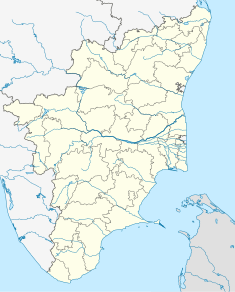Kumarakottam Temple
| Kumarakottam Temple | |
|---|---|
 Kumarakottam Temple towers | |
| Location | Kanchipuram, Tamil Nadu, India |
| Built | Rebuilt in 1915AD |
| Architectural style(s) | Dravidian architecture (Pallava) |
The Kumarakottam Temple is a Hindu temple in Kanchipuram, India. It is dedicated to Murugan, the Hindu war god and the son of the god Shiva and his wife Parvati. The temple is also known as the Subramanyam Swamy Temple. The ancient temple was rebuilt in its present form in 1915.
Location
The Kumarakottam temple is located on the main Raja Street.[1] It is said to form a cluster with Ekambareswarar Temple and the Kamakshi Amman Temple but each temple has its own liturgical identity.[2] The Murugan temple is located between the temples of his parents – the Ekambareswarar Temple dedicated to Shiva and the Kamakshi Amman Temple dedicated to Kamakshi, an aspect of Parvati. Symbolically, this setting represents the iconography of Somaskanda, an aspect of Shiva where he is depicted with Murugan and Parvati. The child Murugan is depicted seated between his parents. This representation led to the cult of Somaskanda.[3] All temples in Kanchipuram are stated to belong to one extended family.[2]
Religious significance
The temple legend in the Kandapuranam – the Tamil version of the Skanda Purana which is mainly devoted to Murugan (also known as Skanda or Kanda) – states that Murugan had imprisoned the creator-god Brahma here for the latter's ignorance of Om, the Sanskrit single syllable mantra which is sacred in Hinduism and himself assumed the role of the creator in this place. However, Murugan's father Shiva had ordered him to release Brahma. When Murugan realized his mistake in not obeying his father’s instruction, he did penance before a Linga (the aniconic symbol of Shiva), which subsequently was worshipped by the name of Devasenapatisar, literally, the Lord who was worshipped by Devasenapati (an epithet of Murugan as the commander-in-chief of the gods).[3] In another version it is said that the penitent Brahma is said to have been released by Shiva after he worshipped Murugan after learning his lessons in humility.[1]
The temple is one of the 21 major temples in Kannchipuram and is an important pilgrimage centre.[4] Saint Arunagirinathar has sung hymns in praise of the Murugan icon of the temple.[5]
Features


The temple, as now rebuilt, has the temple pinnacle (shikara) above the main sanctum (garbhagriha), which is built in granite and is in the shape of a dome called the chakravimanam (circular dome) which is a Chola period structure. The corbels and the pilasters with epigraphs decorate the walls of the temple.[6] The temple has two prakarams (circumambulatory passages) and many of parivara devatas (family deities) are installed in subshrines around it.[5]
The central image of Murugan is uniquely depicted as Brahma-Shasta, holding a kamandalu (water pot) and beads of Rudraksha.[3]
The linga worshipped by Murugan is deified in a separate shrine within the temple complex and is called Devasenapatisar or Senapatisvara.[7]
Kandapuranam

Kachiyapper, a Tamil and Sanskrit scholar, was the priest in the Kumarakottam Temple. He composed the text Kandapuranam. The hall, the Kandapurana Arangetra Mantapam (An outdoor pavilion) where Kachiyapper composed the text still exists in the temple complex. Peacocks flock the premises even now.[3]Kachiyapper wrote the epic in six cantos comprising 10,346 stanzas. It is believed that the first line of the first stanza was written by Kachiyapper's patron deity, Murugan himself. The god is also believed to have corrected the 100 stanzas written by the priest during the day.[8] The poet took his composition to the god and rehearsed it.[9] Even now the priests in the temple are the descendants of Kachiyapper.[5]
Festival
A popular festival held here is Skanda Shashti (in November), 6th day of bright half of the lunar month named after Murugan, also known as Skanda (Kanda in Tamil).[3] During the month of Kartigai (November–December) between the darker half and the brighter half of Moon, celebrations are held in the temple when a very large number of lamps are lit in the temple.[2] The worship in the temple is scheduled six times daily. In every lunar month on the days of the rising star of Krittika (as per Hindu Calendar) festival is held in the temple when very large number of devotees offer prayers to the deity.[5] Each temple in Kanchipuram celebrates the Brahma festival, as Brahmotsavam, when processions of gods are held in the morning and evening hours.[10]
References
- ^ a b Rao2001, p. 56.
- ^ a b c Michell 1993, p. 30.
- ^ a b c d e Rao 2008, p. 109-110.
- ^ Knapp 2009, p. 305.
- ^ a b c d "Temples in Kanchi Near Srimatam". Kamakti organization. Retrieved 22 August 2013.
- ^ Rao2001, p. 55.
- ^ Rao 2008, p. 159.
- ^ Pillai 1904, p. 107.
- ^ Spuler 1975, p. 222.
- ^ Michell 1993, p. 36.
Bibliography
- Knapp, Stephen Knapp (1 January 2009). Spiritual India Handbook. Jaico Publishing House. ISBN 978-81-8495-024-3.
{{cite book}}: Invalid|ref=harv(help) - Michell, George (1 March 1993). Temple Towns Of Tamil Nadu. Marg Publications. ISBN 978-81-85026-21-3.
{{cite book}}: Invalid|ref=harv(help) - Pillai, M. S. Purnalingam (1904). A Primer of Tamil Literature. Ananda Press.
{{cite book}}: Invalid|ref=harv(help) - Rao, A. V. Shankaranarayana Rao (2001). Temples of Tamilnadu. Vasan Publications.
{{cite book}}: Invalid|ref=harv(help) - Rao, P. V. L. Narasimha (2008). Kanchipuram: Land of Legends, Saints and Temples. Readworthy. ISBN 978-81-89973-54-4.
{{cite book}}: Invalid|ref=harv(help) - Spuler, Bertold (1975). Handbook of Oriental Studies. BRILL. ISBN 978-90-04-04190-5.
{{cite book}}: Invalid|ref=harv(help)
Nearest Hindu Temple
- Arulmigu Thirumagaraleeswar Temple, Magaral

